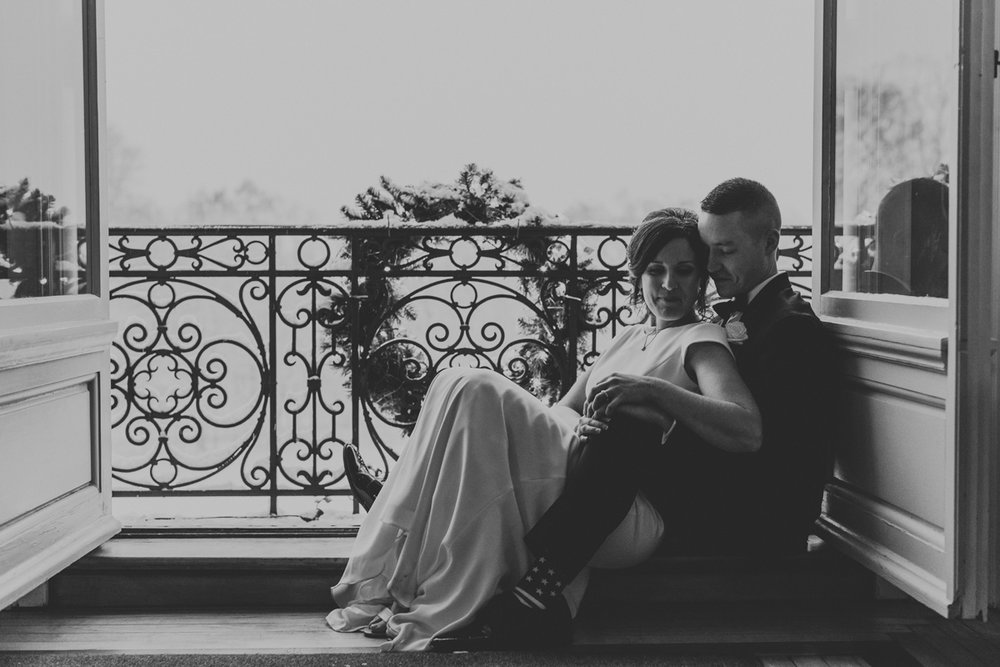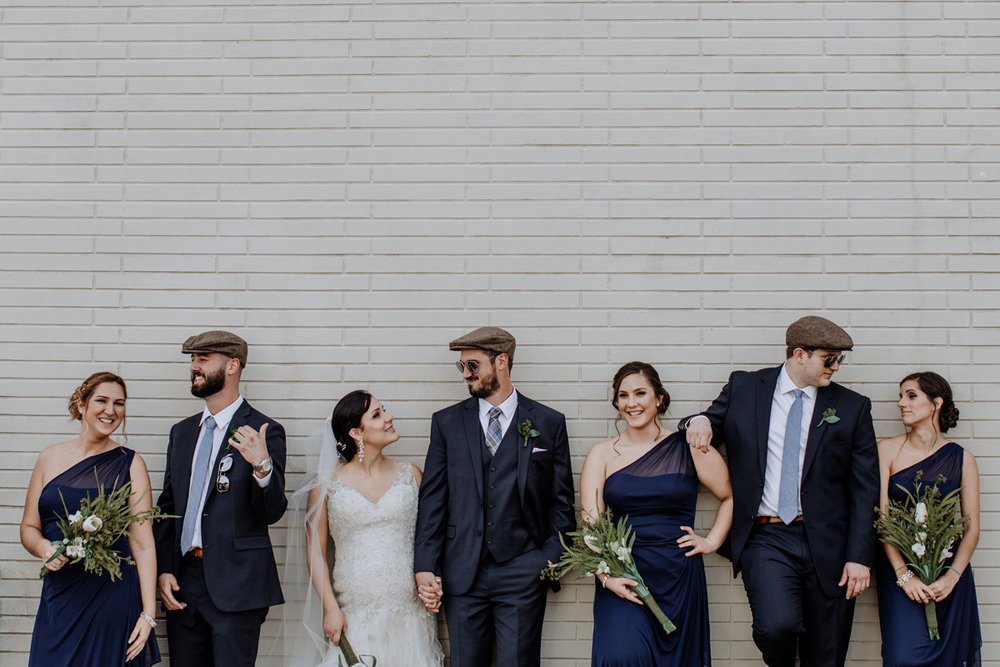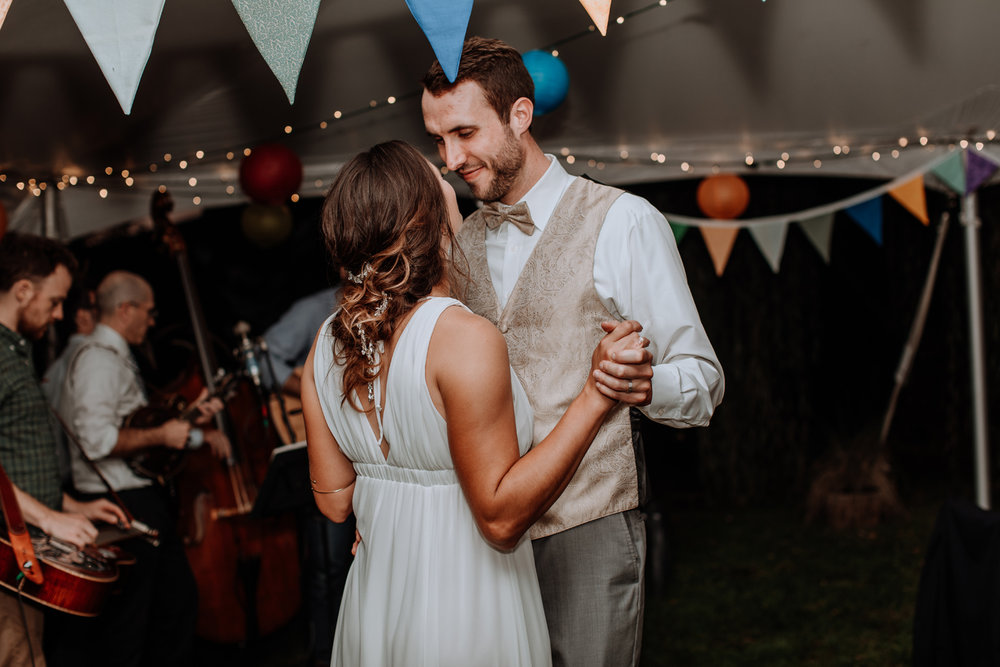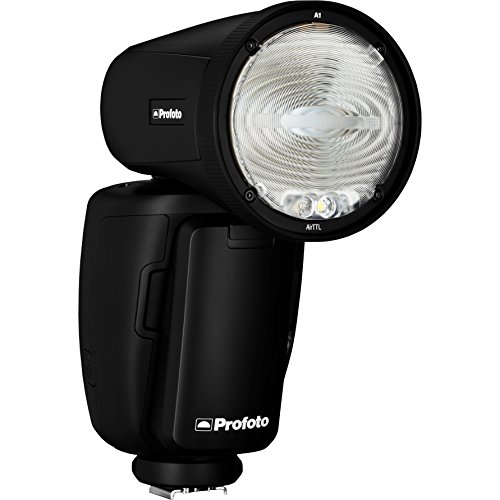
Photographing weddings can be a lot of fun, and come with it’s fair share of challenges, too. Bringing along the right gear for the job is one way to make sure that you will be able to get all the shots you want (and need), and more importantly, get the ones the couple you are working for want!
As a new wedding photographer, it can feel like an uphill challenge to get all the photography equipment that you need and want to create the best art possible for your clients. Unless you are a lucky person who has an infinite amount of money to spend, it will become necessary to determine what items are “essentials,” what items would make life a little easier, and what items are more novelty. For sure, we have a mixed bag of equipment ourselves – some that we use constantly, while others we only use in special instances. For the sake of being transparent, in the first year of running our business, we spent around $30,000 upgrading our old equipment, and getting professional level gear. Keep in mind, this is photography equipment for two photographers, so we would expect a solo photographer to be spending around 15k – 20k ideally assuming you need to purchase new or update camera bodies, lenses, flashes, and other types of equipment that will be of significant use during the wedding day.
A few notes before we begin…
-
Contained below will be referral links to Amazon and other websites. These are provided for your benefit – as they include more detailed information regarding each product (most importantly to us: a lot of user reviews!). Some items are also available in special package deals (at same cost) that may not be available in store or elsewhere online, which may include some freebies like SD card(s), camera backpacks, tripods/monopods, etc. The majority of our large purchases are handled through Amazon for this reason + their consumer friendly return policy. Any purchases made through these links do benefit us as well, as we earn a commission from each sale at absolutely no additional cost to you. There is no obligation, but if you feel the content here is useful and you are looking to purchase new wedding photography equipment, please consider using these so as to support future content like this on our website.
-
All products showcased below are representative of photography gear we use and would recommend to a friend. Our experience with investing in our own photography business has taught us much, and we have made mistakes in the past with purchasing gear we end up not needing, or ended up replacing – in some cases unintentionally. We do not link to gear that we do not get value from.
These are the equipment essentials for wedding photography…
1). Camera and Backup Camera
Let’s start with the obvious! You will need a camera. And not just any “camera,” but a good quality, professional level camera suitable for a diverse range of environments that come up from wedding to wedding – and within an individual wedding day, too. The camera body you choose to use will be up to you, your budget restraints, and specific considerations that you may want to make. These days, there are also considerations to be had for mirrorless camera body options, though we do not use these at this time. With all this said, we recommend the following camera bodies:
We have full reviews of both of these camera body models if you are interested in more detail regarding each. To keep things short for now, the appeal of these camera bodies is the quality of image outputted (particularly when fitted with good quality lenses, which are equally important) and ability to perform better in low light situations. While most “beginner” camera bodies (such as the Canon Rebel series) are decent cameras in certain situations – like well lit, outdoor photography – a quality camera body will show it’s value when you are placed in a less than ideal shooting environment. This happens often during the wedding day, as there are sometimes no alternatives, or no ability to just up and change venues or location. For example, an outdoor wedding ceremony will not be possible to be moved out of dark shade or harsh sunlight, so having the gear foundation to accommodate this, capture the most data (in highlights and shadows), and fix in post production is essential. It also goes without saying (but we’ll say it anyways), there are some shots on the wedding day that cannot be faked, and some shots where you will not get the chance for a repeat. For this reason alone, it is especially important to have the appropriate gear.
As a new wedding photographer, it should also go without saying that it is essential you bring a backup camera. We currently shoot with two primary 5D Mark IV cameras, and have backup 5D Mark III’s on hand. While the 5D Mark IV is a technically better camera, given the cost is nearly double, you could get away with having two 5D Mark III’s. If you are on a tight budget, you might also consider having a backup be something like a 7D Mark II – which is a little less expensive, not quite as good in quality but sufficient enough for a backup (we don’t use this one, but have heard good things about it before!).
One additional thing to keep in mind: there are other brands you may want to consider checking out. We can only recommend Canon as it is the brand of products we have bought into – and for good reason, as they are create quality camera bodies, lenses, and other gear. However, we have generally heard good things about Nikon, Sony, and Olympus as good alternatives as well if those are options you would also like to check out!
2). Professional Lenses

We have learned over the past few years of wedding photography that having the right lenses for the job is essential to take wedding day photos successfully.
We tend to learn something new with each venue we visit, as different locations have different needs. For example, photographing in a Catholic church with a long center walkway to the altar will be drastically different than shooting in a small, intimate venue. The same goes for the scale of venues – some main features such as a large tree in outdoor venues may become a focus of the center of the scene – will require even still different techniques and lens choices. Now, figure all this out with limited time, and you will immediately have a sense of why having the right lenses is necessary, and understanding where they will fit into your workflow, is so important.
Let’s breakdown the lenses we use.
-
Canon EF 70-200mm f/2.8L IS II USM Telephoto Zoom Lens – Review – Ideal for candid shots and getting close (without being close) during ceremonies, can also take beautiful portrait photos.
-
Canon EF 50mm f/1.2 L USM Lens – Review – Our “standard” lens, ideal for use in most shooting scenarios during the wedding day.
-
Canon EF 85mm f1.2L II USM Lens – Review – A beautiful portrait lens, the low f-stop of 1.2 allows us to create a lot of the bokeh effect in our portraits with this lens. This is one of our favorite lenses.
-
Canon EF 24mm f/1.4L II USM Wide Angle Lens – Review – This wide lens allows us to capture larger environments and the couple in the context of the environment. We also use it for some interesting portraits from time to time.
We still have a few other lenses we are going to be investing in this year ourselves including the Canon EF 100mm f/2.8 Macro Lens and Canon EF 35mm Lens, and will update if we find our wedding days to benefit from these additions. We used to heavily use the Canon EF 135mm lens, but since purchasing the 70-200mm, it’s use has really been minimized for us. With that said, it is a beautiful lens and excellent for portraits, it just is not a “necessary” purchase.
Of all the lenses currently on this list, if you are on a significant budget but still want pro level lenses, you could get away with shooting strictly with the aforementioned 70-200mm and 24mm, and substituting the more expensive 50mm with the “nifty fifty” (Canon 50mm EF f/1.8). We used this combo for a while when strapped for cash early on, and it worked reasonably well. Since upgrading the 50mm, there is a distinct difference, but most clients won’t notice the difference in quality.
If you’re looking for more information regarding the camera lenses we use regularly in our wedding photography, check out The First Canon Lenses You Should Buy for Wedding Photography.
3). On Camera and Off Camera Flash Setups
If you are currently a “natural light” photographer, and want to take your wedding photography to the next level – you will need to learn how to use flash. During the course of a wedding day, in particular the reception, flash is essential for producing quality photographs. Relying just on your camera’s ability to shoot in low light (by upping the ISO) is not going to be sufficient, as at a certain point, even the best camera bodies will output a lot of grain in low light and dark environments.
The topic of flash photography really requires much more attention than a quick blurb, so for this section we will simply list the gear we utilize to create an effective flash set up. We will actually put on display 2 separate setups – the first is more budget friendly (and representative of our initial wedding flash photography setup), while the other is what we are currently using since being able to upgrade. We will provide brief explanations regarding the pros and cons of each, as well.
Setup #1 – Standard Speedlight(s)

When we started our business, upgrading our flash from simple built-in or really inexpensive flashes we had played around with from time to time was essential. While we have always been solid photographers, utilizing flash has never been something we really needed to do prior to shooting weddings. Our investment into a good flash system was essential, and this “kit” we put together and have used to photograph receptions (in particular) is quite good – given the cost to entry is substantially lower than some other flash setups – as you will see in Setup #2. Keep in mind, as we are two photographers, we have some duplicate items – but for this purpose we have provided a list of items for a single photographer setup with one on-camera and one off-camera flash.
-
Manfrotto 368B 11-Feet 5/8-Inch Stud and 015 Top Basic Light Stand
-
Panasonic BK-3HCCA8BA Eneloop Pro AA High Capacity Ni-MH Pre-Charged Rechargeable Batteries
-
Neewer® Heavy Duty Photographic Sandbag Studio Video Sand Bag
One of the first challenges of learning flash is figuring out all the technical components. For sure, this is one major element that separates professional wedding photographers from people who “take pictures.” While it’s not exactly rocket science, it can feel like a huge hurdle to get over as there are many technical components at play – both in terms of actual products (speedlites, receivers, batteries, umbrellas…) and the positioning of these things relative to your subject(s).
This setup provides the basic essentials for a professional quality flash system. All of this equipment combined will cost around $1,000 or so. While not “cheap” by any means, considering all the things you get for the cost – not bad as far as investments go into your photography business. And certainly more budget friendly than our next kit suggestion…
Setup #2 – Profoto Professional Flash System
While our initial flash setup is functional, and honestly pretty close to what a lot of current photographers do use from what we have seen, it has flaws that are significant to our personal workflow. Flaws significant enough to us that we were will to replace most items on the list with substantially more expensive equipment. While our next recommendation may not be for “beginners” or those on a budget, we put it here to showcase our current setup – and more importantly – showcase what we consider to be a better option if it is within your budget. No doubt, we were forced to take a loss selling some items from before as used – and ultimately we believe buying the best gear possible helps to save costs down the road.
Around the professional photography community, Profoto is a well received brand known for being costly – but also being an example of having product lines where “you get what you pay for.” We agree on this, for sure! We were initially intrigued by the new Profoto A1 Air Speedlight, due in heavy part because of the ease of use. While other flashes can be great in quality, their menus are not user friendly. With Profoto flashes, the interface is far more appealing, streamlined and intuitive to use. Additionally, we were also satisfied to do away with having 50 rechargeable batteries on hand at all times, and no more need for the PocketWizard receivers as this functionality is built in.
-
Manfrotto 368B 11-Feet 5/8-Inch Stud and 015 Top Basic Light Stand
-
Neewer® Heavy Duty Photographic Sandbag Studio Video Sand Bag
At it’s core, this flash setup provides a lot of things of value to use: it is easier to use and setup, the light quality is noticeably better, and the resulting images are better for it. For a single Profoto brand on-camera and off-camera flash as shown in this setup, this kit will cost around $3,500.
4). Memory Cards & Batteries
After all that flash talk, it’s nice to get back to something a little easier to understand 🙂 Every photographer will need memory cards and batteries for their wedding day shoot, and lots of them. When starting off, it was definitely a fear of ours to suddenly run out of battery power or have a memory card corrupt on us. It’s a lot to think about, but it’s better to go to a wedding prepared than unprepared and have something go horribly wrong.
Speaking of memory cards, it is fairly simple – buy a few high quality and high storage cards (think 64GB+). Between the 2 of us, an average wedding day can leave us with over 3,000 RAW camera files – which easily can fill smaller storage cards. Also, while it may not be something you think of normally, having a card that can keep up with the pace of your shutter finger is also critical on a wedding day. Some (usually less expensive and off brand) cards might be functional for a hobbyist, but a professional photographer will want cards with higher write speeds that can keep up. Some that we use and recommend include:
One trick to acquiring extra memory cards is to buy camera bodies, lenses, and other gear in kits off of Amazon. Every time we buy gear like this, we find kits that include extra freebies like memory cards, batteries, etc. We’ve aggregated a handful of 64GB cards this way, and won’t complain!
As for batteries, well this is even more simple. There will obviously be batteries to power specific things like your flashes/receivers (for which we recommend Enloop Rechargeable AA’s). As for camera batteries, buy name brand or well reviewed off brand – we have different types ourselves, and there isn’t a huge difference between them from what we have seen. With that said – stock up. Unfortunately, batteries sometimes can die due to temperature and other conditions (ghosts…maybe…). For an average wedding day, we tend to have a bag of 10-15 spare batteries just in case. It’s maybe overkill, but better safe than sorry.
5). Other Misc. Gear
Most other gear is not nearly as essential as having quality foundational photography equipment, but serves a significant purpose as a part of our personal wedding workflows. As you will see, some elements impact us personally on the wedding day, while others may be small add ons that we bring into photos – but maybe not as “necessary” expenses.

-
This is an example of a purchase that is valuable for photographing wedding days in particular – because this is an environment that constantly changes, sometimes so fast that actually going to a bag, swapping a lens, and getting back “into the field” can be too long. Generally, people in other fields of photography do not face this sort of requirement to capture fast paced, candid shots. A lot of moments that happen during sports photography, travel photography, or landscape photography tend to be much more choreographed – or better put – you can see the moment coming from a ways away and prepare better in advance. With weddings…not so much in many cases. While we have a basic timeline, things change all the time – and rapidly at times. The Holdfast Moneymaker is just a fancy (and good looking) leather harness that is used to carry two camera bodies (equipped with different lenses usually). It relieves some strain of carrying cameras around as they hang to your side when not in use, and allow for easier access to a different lens setup quickly. During ceremonies, one example of the usage could be having a 70-200mm lens on one camera body, and a wide angle lens (like a 24mm) on the other. This makes it perfect for quickly capturing diverse moments and image types. It’s helpful for us, but not really “essential” for someone just starting out – but does make the process of getting a different type of shot (that is more dependent on the lens) much easier in the moment.
-
Our primary camera bag is this: BAGSMART Anti-theft Professional Gear Backpack for SLR/DSLR Cameras & 15″ Macbook Pro with Waterproof Rain Cover. This manages to hold the majority of our gear that we need at all times throughout the wedding day. Certain other items, such as larger flash setups, tripods, light stands, etc. are all carried in separate specialized bags – most of which come with the purchase of those items. The bag we note above is great, and we say so having tried several different camera bags and finding them not to work as well as we would have liked. This bag comfortably fits multiple camera bodies, multiple lenses, batteries, SD cards, etc. It is also sized well to be carried onto an airplane if you are traveling (first hand experience on this going to Iceland with it). Not a complex purchase, but one that is essential to lugging around all the wedding day photography gear!
-
How do you deal with rain on a wedding day? Well, having a good set of photogenic umbrellas helps. As photographers, we can’t control the weather, and usually have to just work with what we have. While shooting in rain is less than ideal in most situations, it can make for some beautiful shots. Coming prepared – both for yourself and your clients – can pay off pretty quickly.
-
Artistic accessories such as copper piping, prisms, suncatcher, etc.
Of all the things on our list of essential wedding photography equipment, these are fortunately some of the cheapest – and can make your photos stand out for sure. Copper piping can be used to get the “Ring of Fire” effect during Golden Hour portraits, while prisms and suncatchers can be used to add interesting splashes of color…really the list of options for these sorts of things are pretty much limitless. Find a few things that work for you, and implement them into your wedding day photography!
At the end of the day, the most essential gear for wedding photography are those products that allow you to capture the images you need to capture.
While starting your photography business may have a lot of cost involved, once you have the core gear, you can concentrate strictly on honing your art and learning how to better take advantage of quality equipment – as opposed to fighting with cheaper gear. We learned this ourselves with some early purchases, and while we are not made of money, we have had better luck since updating to higher end, professional gear.
We hope that this article has been useful for you. We have learned a lot since starting our own photography business last year, and now with many bookings under our belt, and many more to come, we go into this new wedding photography season better prepared, and better equipped!
If you have any questions about the wedding photography gear you see here, feel free to ask us below! We are happy to help!!
